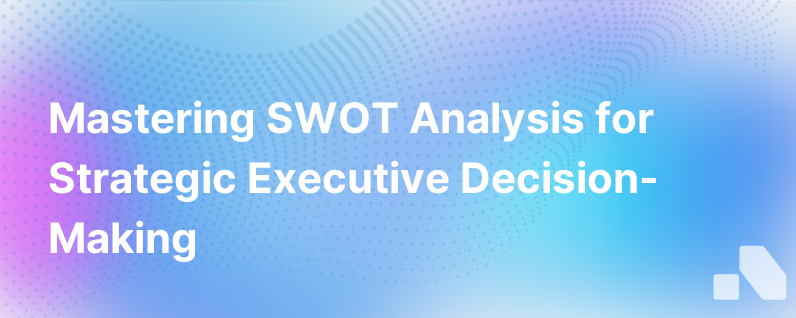
A SWOT analysis is a respected and truthful managerial method that is often overlooked due to its simplicity. However, it can be incredibly powerful when utilized correctly. It is a simple yet effective tool that can be used to identify internal Strengths and Weaknesses, as well as external Opportunities and Threats (hence SWOT) for any organization or initiative. Regardless of its simplicity, a well-conducted SWOT analysis can bring clarity to critical business strategies and business decisions.
If your startup is trying to gain a competitive edge, needs a strategy to attract investors, or unveiling a new product or service, a SWOT analysis promises definite action once the right steps are taken.
What is a SWOT Analysis?
Before we delve into the process of conducting a SWOT analysis, it's key to understand what it entails. It's a tool that identifies the positive and negative internal and external aspects that affect an organization's success and progress. More specifically:
- Strengths are your company's internal assets or advantages that you can leverage to achieve your goals.
- Weaknesses are internal factors, including limitations or deficiencies, that hinder your growth.
- Opportunities represent external conditions that your company can exploit for its benefit.
- Threats designates external elements that could endanger your company's growth, success, or even survival.
The Process: How to Conduct a SWOT Analysis
Conducting a SWOT analysis requires four basic steps:
-
Identify the Objective: What do you want to achieve? This defines the direction of your analysis. For example, aiming to penetrate a new market will yield different SWOT factors as compared to launching a new product or service.
-
Research: Intensive and insightful research is crucial to gather information about your strengths, weaknesses, opportunities, and threats. This involves market studies, customer or employee feedback, financial reports, sales data, and competitor analysis.
-
List the SWOT Factors: Based on your research, list down all the factors under the four SWOT categories. Remember, strengths and weaknesses are internal; opportunities and threats are external.
-
Analyze Your Findings: Reflect on the data you have gathered. How do your strengths and weaknesses align with the external opportunities and threats? Analyzing these components helps in shaping strategies for growth.
Leveraging a SWOT Analysis
Once a SWOT analysis has been conducted, it's critical to use the insights constructively to form your strategies. Here's how you can leverage your SWOT analysis:
- Empower Strengths: Leverage your strengths to capitalize on opportunities and counter threats. Can your strengths be used to improve your weaknesses?
- Addresses Weaknesses: Develop plans to eliminate or minimize these. Should resources be dedicated to controlling weaknesses or should the focus be on strengths and opportunities?
- Seize Opportunities: Use your strengths to seize these opportunities, but also investigate how they could fight your weaknesses.
- Neutralize Threats: Identify ways to decrease your vulnerability to these threats by using your strengths and reducing weaknesses.
Key Considerations for SWOT Analysis
- Accuracy and Honesty: A SWOT analysis requires honesty. Over-estimating strengths or under-estimating weaknesses won't provide the insights for strategic planning and improvements.
- Prioritize: Not all points you list under the four categories will be critical. Prioritize them based on their potential impact.
- Collaboration: Include perspectives from various teams or departments while conducting the SWOT analysis. This ensures a well-rounded understanding of your business.
- Updating: A SWOT analysis is a snapshot of a particular period. Businesses change, and so do their internal and external environments. Keep your SWOT analysis updated.
Aomni: Your Partner in Growth
Now that you understand the process and benefits of a SWOT analysis, it’s time to put your insights into action. Aomni, an AI-powered B2B sales platform, can leverage the insights from your SWOT analysis to provide real-time account research, actionable competitive insights, and personalized sales content.
Aomni's purpose-built AI sifts through your internal and external business landscapes, synthesizing data and streamlining decision-making processes. It provides the tools you need to tap into opportunities, manage threats, maximize strengths, and mitigate weaknesses affordably and efficiently.
Conclusion A SWOT analysis is a remarkably powerful tool when conducted earnestly and strategically. It provides concise, actionable insights into your strength, weaknesses, opportunities, and threats - shaping effective strategies and improving the decision-making process.
With experiences across different sectors and startups, we recommend leveraging AI tools like Aomni during SWOT analysis execution to increase your efficiency, broadening your horizon, and ultimately, gaining a competitive edge that drives your business growth.